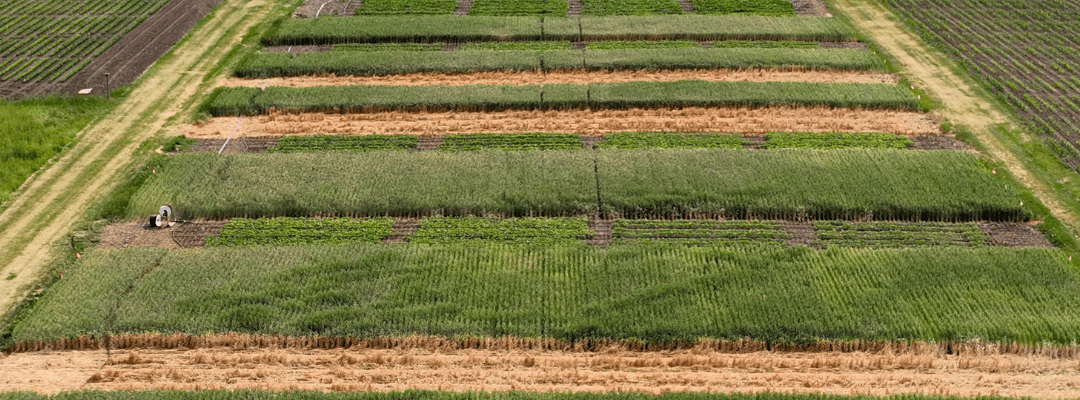Throughout the years, the processes behind both data capture and analysis have evolved to meet the dynamic needs of ag research. Whether it be subjectivity, labor shortage constraints, or other limitations associated with manual data collection, technological innovations have stepped up to fill shortcomings.
Remote sensing (via ag drones and sensors) has provided that technological steppingstone needed to solve a variety of concerns surrounding data capture. And paired with machine learning, this side of digital ag has boosted efficiency and accuracy in not only collecting data but also analyzing it. Aerial imagery provides an eye-in-the sky view, generating powerful and valuable analytics and insights across research plots.
Just like playing your favorite song on repeat, there are always going to be “go-to” analytics that provide just what you need to know – and continue to be what you rely on for seasons to come.
But to ensure the success of every aspect of trials, going beyond the surface data is critical to gaining a deeper understanding. These foundational measurements serve as accepted proof points for validation, but what if you want to venture beyond these core analytics?
Building the Foundation: The Core Four
Similar to building a music career, to truly gain an understanding of field or plot performance, you must lay a strong foundation with some tracks that become instant favorites. In ag research, the four “foundational” metrics include:
- Normalized Difference Vegetative Index (NDVI)
- Normalized Difference Red Edge (NDRE)
- Crop Health
- Canopy Cover
Today, these are some of the most commonly used analytics in determining successes and failures in ag research and development efforts. It’s no wonder why – they each provide a distinct view into performance at the plant level.
As the most common multispectral indices, NDVI and NDRE, unlock insights that would otherwise be undetectable. Measuring plant health based on how the light reflects differently off plants due to varying chlorophyll levels helps to uncover how a plant is growing, how it is behaving in its specific conditions and with key inputs, plant stress level, and overall health of the plants across your plot.
Like any of the greatest hits of later generations, they often build on the successes of what has been laid by previous stars. Crop Health does just that – building upon the most popular multispectral indices and delivering more detailed measurements to truly gauge what’s happening in the field.
Sentera’s Crop Health analytics, for instance, include metrics that indicate subplot data points, like the median, standard deviation, and range. And, for broad scale applications, it can help detect plant stress, disease, nutrient status, and even yield or biomass potential.
Plus, by exporting this data to CSV, it can provide plant-level measurements for analysis and comparison throughout the season.
And Canopy Cover helps to understand exactly how plants are developing and maturing. By characterizing growth stage, you’re able to access early indication of growth and health while ballparking yield potential. Following along with the plants through each growth stage allows you to understand performance and how different traits or variations are performing – and that’s why a valuable element of Canopy Cover is being able to deliver metrics that demonstrate how the extent of vegetation has changed over time.
With these four key plant measurements, get valuable insight into your plots and help to validate outcomes with standardized, consistent measurements. But sometimes a deeper look into performance and key attributes can be helpful. So, which provides that extra layer to truly validate product performance?
Digging Deeper: Uncovering Valuable Plant Measurements
Nearly every researcher and developer have the instinct to peel back an extra layer of depth into what they are working on. And the same goes when seeking deeper plant measurements to understand every aspect of how their plots are performing. Understanding and measuring performance goes beyond plant health and general growth. By getting that extra layer of additional analytics, you’re able to make more accurate, informed decisions as well as validation and prediction.
What are these analytics that go beyond the plant measurements “greatest hits”?
Stand Count is a classic; one you can rely on to give insight into early season emergence – helping to indicate what’s happening as early as the V2 growth stage. Getting insight into emergence, and key uniformity metrics, can help indicate more than how your plants are growing – it can help inform key decisions around plot quality.
Beyond that, for broader scale applications Male/Female Stand Count can give indication into how male and female row planting pattern are performing. With key measurements like male and female plant density, male and female emergence, and male and female seed spacing (expected vs. average vs. median), it can offer insight into hybrid seed production to start informing forecasting early in the season.
And, later in the season, Male/Female Tassel Count can help validate detasseling operations – providing insight into the purity of the field. This is done by sharing counts for male and female tassels, as well as the percent of tassels in the image that are either male or female.
Biomass hits the ranks as a greatest hit for plant measurements; but it’s not a one hit wonder – when measured the right way. At the most basic level, biomass gives an indication of how much greenery exists within an area of the field, as it is generated via multispectral imagery based on how much light the plant reflects.
A more effective indication of biomass evaluates height while measuring the 3D volume of a plant to truly understand how much greenery exists – and thus, what the absolute biomass is of the plant during that time of the season. Biomass can help indicate energy stores for a plant, which demonstrates the potential productivity and overall health for that particular plant. With the more effective measurement of biomass, this turns Canopy Cover into a greatest hit that’s never left the top 10.
Cotton and canola benefit from measurement during flowering fruit retention – after all, this can be a strong indication of productive seed pods. Most importantly, Flower Cover analytics can indicate initial yield while helping to provide insight into stressors like disease. Flower Cover allows researchers and product developers to easily quantify the fraction and uniformity across their plots – helping to pinpoint growth stage, development, and maturity. By using the data provided by this ag analytic, you’re able to see where performance is varying, helping to inform trait selection based on how they are reacting in said conditions.
One last insight that offers deeper analysis into performance: Plot maturity date. Using agronomic modeling, maturity date can be informed by other key variables to measure the timing of harvest readiness to help researchers evaluate the performance of germplasm and inform selection and product development decisions.
While the core four analytics serve as valuable resources in validating product performance, augmenting analysis with additional data sets can help inform critical decisions while also providing supplemental data. With the help of ag drone systems and machine learning platforms, researchers and developers can better inform decisions and validate outcomes in a timely and accurate manner.


